Human Flower Project
The Marriage of Betel Leaf and Areca Nut
An old combination of Asian plants has been put to nearly every use—from preventing widowhood to sparking conversation. Paan is pan-cultural.
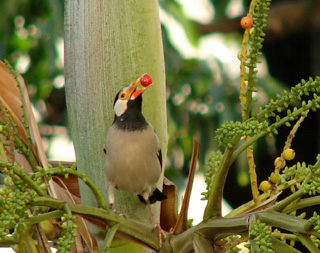
Minah bird and immature areca nuts (a.k.a. “betel nuts’)
Kolkata, India
Photo: Sandy Ao
With this lively photo of an Indian minah bird enjoying berries, Sandy Ao pulled back the curtain on a strange and manifold cultural epic.
In a word: paan.
The minah is relishing young berries of the areca nut tree (Areca catchu), a palm native to much of Southeast Asia. It’s the nut of this tree, with a chemistry that’s highly stimulating to humans, that’s wrapped in a glossy betel leaf (Piper betle) and chewed—as paan. Often the leaf will be smeared with a paste of mineral slaked lime, so the psychoactive and mildly addicting plant ingredients keep their gentle kick.
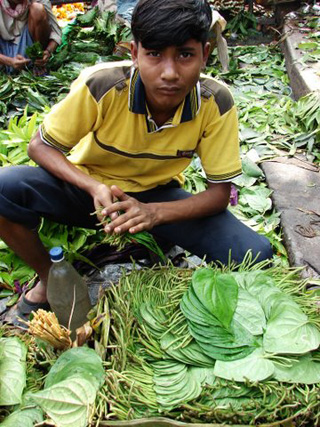 Betel leaf seller
Betel leaf seller
Mullickghat market
Kolkata, India, Feb. 2009
Photo: Sandy Ao
Sandy took pictures at Mullickghat market in Kolkata just this week of both the betel leaf sellers and paanwallahs making up their druggy plugs. Has anybody tried one?
To the Westerner, it may all sound raunchy, the Oriental equivalent of Skoal. But these two plants – betel leaf and areca nut – possess a venerable, braided heritage not just in India but across East Asia. The two are so closely associated that areca nut is often referred to as “betel nut” (non-English speakers don’t confound their names).
“The betel begins the conversation” goes a saying from Vietnam; it’s still considered a courtesy to offer guests betel and acacia. Just as Native Americans (and teenagers) have shared tobacco to draw bonds of trust and conviviality, so paan chewing is a way of “getting to know you” – a distraction and expression of intimacy at the same time.
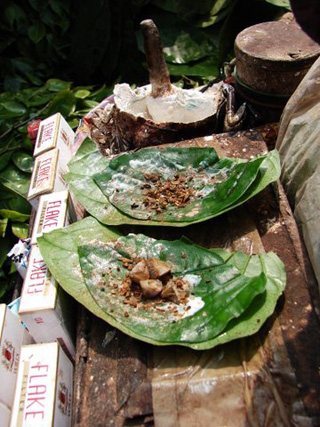 Making a paan quid: betel leaf, lime, and areca nut
Making a paan quid: betel leaf, lime, and areca nut
Photo: Sandy Ao
Where did the custom come from?
One source says paan chewing was popularized by Queen Noorjehan, the mother of King Shahjehan who ordered up the Taj Mahal. But from paan’s many ritual uses across Asia, we’d imagine that people in the subtropics came upon this little pick-me-up far longer ago. As with fermented grapes, news of this kind of thing travels fast.
Sandy writes that in China, “When a marriage takes place, the bridegroom’s family invites guests with the usual invitation card, whereas when the bride’s family invites the guest, it is with a betel nut inside a small red paper packet.
“When there are two un-cut betel nuts inside the red paper packet, it indicates the bride is inviting the whole family of the guest. And if inside the red paper packet, the betel nut is in cut pieces, it indicates the bride is inviting not more than two members of that family.” The same goes for birthday celebrations.
Leave it to plants to bring subtlety – and clarity – to these anxiety-producing social preparations.
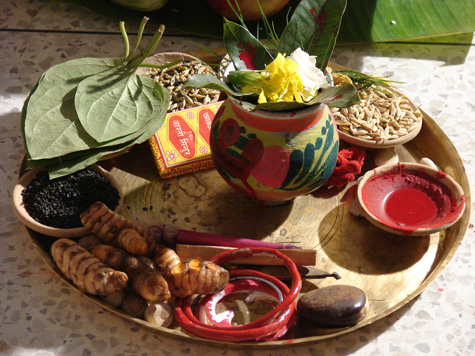
Betel leaf, areca nut and other sacred offerings at a Bengali pre-wedding ceremony
Photo: Sandy Ao
Sandy also photographed betel leaf and areca nut in a Bengali pre-wedding ceremony. Here along with other sacred herbs and flowers, areca nut and betel leaf are presented to be blessed by the Hindu priest. In Rajasthan, the NW Indian state bordering Pakistan, paan chewing is popular also; betel leaf is part of wedding tradition here, too. “The bridegroom’s relatives have dinner only after the bride’s relative serves a betel leaf to everyone,” a ceremony called Niyona.
In Vietnam the phrase “matters of betel and areca” (chuyện trầu cau) is synonymous with “things marital.”
Perhaps the most feminist wedding tradition we’ve ever heard of involves areca. Among the Newa people of Nepal, a young woman accepts a betel nut as a marriage proposal and, in fact, she marries the betel nut too before formally taking a husband. “Accepting betel nut (Gwaye kayegu) means she accepts the bridegroom. Also she can simply leave the (groom) even after marriage by giving the betel nuts back.” According to custom, and what a custom it is, an unhappy wife “puts betel nuts below her husband’s pillow when he is sleeping and is free to leave him and choose another.”
By marrying the areca nut first, says one source, no woman ever becomes a widow – thus she’s freed of the obligation to throw herself on her husband’s funeral pyre should he pre-decease her.
Gwaye kayegu is as strong an example of the human-flower project as any: literally a life-or-death pact between people and the plant world.
 Red juice from paan, spat out in a Kolkata stairwell
Red juice from paan, spat out in a Kolkata stairwell
Photo: Sandy Ao
We’ve also been introduced to two newer paan customs. In contemporary India, paan that’s been pre-packaged, ready to chew, is called “supari.” Sandy reports that “to give a supari” means to contract for someone’s death: “supari killing” is a gangland murder. Salivated paan turns bright red in the mouth, and as Sandy’s photography attests, there are signs of it all over Kolkata. The stain of supari makes many innocent street corners look like crime scenes.
Crime, misdemeanor, or neither? From photographer Tobie Openshaw we have learned of the controversial “betel nut girls” of Taiwan. In skimpy clothes, young women hawk colas, cigarettes, and betel/areca plugs. They sit on public display behind picture windows and rush out to the curb selling wares to a drive-by clientele.
Tobie has been photographing the “betel nut beauties” of Taipei for several years and presents a sad but amazing set of images on flickr.
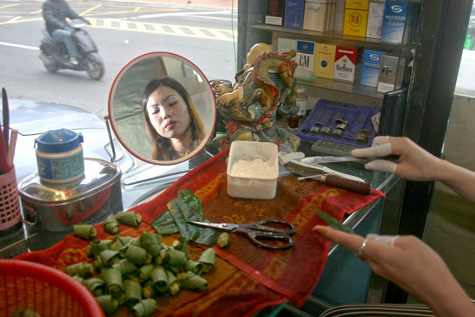
Mandy in a mirror (a “betel nut girl” in Taipei)
Photo: c. Tobie Openshaw
The photos are provocative in many ways (like the old National Geographic images of African “tribespeople,” this ethnography – as our own– always involves a strain of prurience).
Recreational drug, ceremonial offering, invitation, medicine, vendetta…. Is there any dimension of human experience paan hasn’t reached? To the utilitarians and ornamentalists out there, we offer this glimpse of betel culture – old, new, wide, deep. As always, we thank Sandy Ao for her teaching, artistry and insight.
Comments
Julie,
Thank you bring out such dream-like post for this pretty bird and its nut…
Thanks for this interesting and timely post, timely for me because I just finished reading “The White Tiger”. Paan is everywhere is this novel, constantly used by the less privileged classes and, as described, covering everything in close proximity and staining teeth. Now I know more about it.


Thank goodness you marry the betel nut first to prevent throwing yourself on a pyre if your husband predeceases you.
Sandy’s photographs are evocative – I feel like I am in the scene of her pictures.